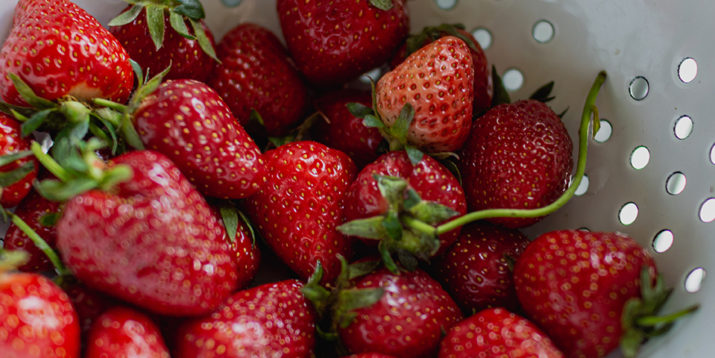How to Store Strawberries So They’ll Last Longer

Is there anything better than snacking on perfectly ripe, sweet, and juicy strawberries?
One catch: Much like the blink-and-it’s-rotten avocado, strawberries don’t last forever.
Those plump red berries you picked up at the farmers’ market today might lose some of their luster after a few days.
So you may be wondering how to store fresh strawberries so you can enjoy every last one.
We asked the experts to share their best tips and tricks for how to store strawberries — so you can enjoy every last one of them.
5 Tips for Storing Fresh Strawberries
One cup of raw strawberries provides vitamin C, fiber, and key minerals. So you definitely don’t want to miss out on the nutritional benefits of strawberries by having them get wilted or moldy in the fridge.
Once you’ve purchased your perfect strawberries, the clock starts ticking.
“Strawberries last 3 to 7 days in the fridge,” says Aja Gyimah, RD, a registered dietician specializing in sports and exercise nutrition.
Use these tips and tricks to get the longest storage life for your strawberries.
1. Select the best strawberries
According to California Strawberry Commission, strawberries do not continue to ripen after harvest — so it’s important to choose the ripest, reddest strawberries you can find.
They recommend looking for berries with “a bright red color, a natural shine and fresh-looking green caps.”
Be sure to pick up the container and look at it from all angles to avoid packs that have strawberries already starting to spoil.
2. Remove moldy berries ASAP
As soon as you get home from the store, open the container and give each berry a thorough once-over.
“It is fine to keep them in the container they came in — just make sure to sort through them and remove any berries with mold on them,” says Leah Forristall, a registered dietitian and owner at Simply Nutrition as well as ServSafe-certified food safety expert. “This will help to prevent the mold from spreading.”
3. Store them in the refrigerator
Your counter may be a fine place to store citrus, apples, and avocados, but strawberries will be happiest snuggled into a cool corner of your refrigerator.
The cool temps help to keep strawberries firm and stave off spoilage.
The California Strawberry Commission recommends refrigerating strawberries as soon as possible. Store them in their original clamshell packaging, or in a container lined with a paper towel.
You can also transfer them to a container specially designed for storing produce.
“Most are ventilated, allowing the fruit to remain dry without completely drying out,” Forristall says. “That being said, you still may not see too much of a difference.”
4. Don’t wash strawberries until you’re ready to eat them
While you may be tempted to rinse those farm-fresh berries under the faucet when you bring them home, resist the urge.
“Stay away from introducing any moisture to strawberries, as they become waterlogged, mushy, and lose all their scrumptiousness,” says Gabriel Contreras, current Executive Chef at True Food Kitchen in El Segundo, CA.
5. Try a vinegar bath
If you’re hoping to squeeze a few more days out of your latest haul, consider rinsing your strawberries in one part vinegar to three parts water.
“Soaking strawberries in a solution of part vinegar, part water can help extend the shelf life by maybe a couple of days,” Forristall says.
However, you’ll need to dry the berries completely before storing them. “Berries are extremely prone to mold, so it is best to keep them as dry as possible until you are ready to eat them,” Forristall explains.
How to Freeze Strawberries
By freezing strawberries, you can enjoy this yummy summer fruit all year long. Strawberries can be stored for months in the freezer when properly prepared.
To freeze strawberries whole:
- Rinse and then gently pat dry.
- Slice off the stem and place cut side down on a baking sheet lined with parchment or wax paper.
- Place uncovered in the freezer for a minimum of six hours and up to 24 hours.
- Transfer strawberries to a plastic freezer bag or container.
If you’re planning on using your frozen strawberries in smoothies, pies, or drink recipes, you may want to slice the strawberries before freezing.
“From my experience, removing the hull and quartering the berries [is] the easiest for storage,” Contreras says.
Sliced frozen strawberries will incorporate more easily into smoothies and thaw more quickly for sauces and other cooking applications.
How to Preserve Strawberries
Preserving strawberries is another great way to enjoy them well into fall and winter. “You can preserve berries that are starting to fade, but never anything that is so far gone you wouldn’t eat it,” says Sherri Brooks Vinton, preservation expert and author of Put ‘Em Up! Fruit.
While strawberries are often preserved as jam, they can also be canned whole in a sugar syrup, Vinton says.
Another option?
Try Vinton’s strawberry-infused vodka: Fill a sterilized jar with clean, hulled strawberries and top with vodka. Secure with a lid and shake.
“Give it a turn every few days for a week or two,” Vinton says. “Then strain, return to a freshly sterilized jar, and enjoy in your favorite cocktail!”
6 Ways to Use Strawberries
Put those stored strawberries to good use with some of our favorite strawberry recipes!



